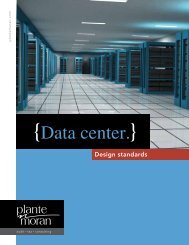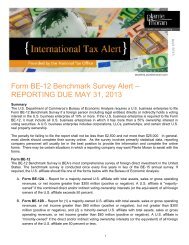Is the New Combined Defined Contribution/Defined ... - Plante Moran
Is the New Combined Defined Contribution/Defined ... - Plante Moran
Is the New Combined Defined Contribution/Defined ... - Plante Moran
Create successful ePaper yourself
Turn your PDF publications into a flip-book with our unique Google optimized e-Paper software.
September 15, 2009<br />
<strong>Is</strong> <strong>the</strong> <strong>New</strong> <strong>Combined</strong> <strong>Defined</strong><br />
<strong>Contribution</strong>/<strong>Defined</strong> Benefit Plan<br />
Worth Considering?<br />
One of <strong>the</strong> many potential changes brought by <strong>the</strong> Pension Protection Act of<br />
2006 was Internal Revenue Code (IRC) section 414(x). This new addition allows<br />
employers to combine defined benefit and defined contribution retirement plans,<br />
with <strong>the</strong> combined plan automatically satisfying <strong>the</strong> top heavy and certain<br />
nondiscrimination rules of IRC sections 416, 401(k) and 401(m); however, plan<br />
sponsors must pay a price.<br />
Starting in 2010, plan sponsors with 500 or fewer participants are permitted to<br />
combine defined benefit and defined contribution plans into one plan with <strong>the</strong><br />
assets held in a single trust. In exchange for meeting requirements with respect<br />
to benefit levels, employer paid contributions, accelerated vesting and<br />
nondiscrimination, <strong>the</strong> plan sponsor avoids having to test <strong>the</strong> plan for top heavy<br />
status and certain nondiscrimination requirements related to employee<br />
contributions and employer matching. The question is whe<strong>the</strong>r <strong>the</strong> inflexibility<br />
and magnitude of <strong>the</strong> requirements make it worthwhile.<br />
Top-Heavy Plan<br />
Generally, a qualified retirement plan fails top-heavy testing if 60% or more of <strong>the</strong><br />
benefits are for key employees. The consequences of such failure are:<br />
a) Application of certain vesting to participants – 100% after 3 years of service<br />
or 20% grading of vesting with 2 years of service up to 100% after 6 years,<br />
and<br />
b) Minimum contributions or benefits – 3% of compensation for defined<br />
contribution plan participants and 2% of average compensation times years<br />
of service (not to exceed 20%) for defined benefit plan participants. For<br />
employers with both types of plans, <strong>the</strong> top-heavy benefit need only apply to<br />
one plan.<br />
Failure of IRC Sections 401(k) and 401(m)<br />
<strong>Defined</strong> contribution plans that fail <strong>the</strong> nondiscrimination testing associated with<br />
employee contributions under IRC section 401(k) and <strong>the</strong> employer matching<br />
contribution component of 401(m) generally are able to ei<strong>the</strong>r a) make additional<br />
employer contributions or b) refund monies to highly compensated employees.<br />
Usually, <strong>the</strong> most efficient way to pass o<strong>the</strong>rwise failed tests is to refund monies<br />
to affected employees.<br />
1
IRC Section 414(x) Permits <strong>Combined</strong> <strong>Defined</strong> <strong>Contribution</strong>/<strong>Defined</strong> Benefit Plan<br />
Implementing a <strong>Combined</strong> <strong>Defined</strong> <strong>Contribution</strong>/<strong>Defined</strong> Benefit Plan<br />
Generally, for automatic compliance with <strong>the</strong> aforementioned top-heavy and nondiscrimination rules IRC<br />
section 414(x) requires:<br />
a) Application of certain minimum vesting standards – 100% after 3 years of service for defined benefit<br />
contributions and immediate vesting in employer matching contributions,<br />
b) Minimum contributions or benefits – matching contributions of 50% of <strong>the</strong> first 4% of employee elective<br />
contributions (not to exceed 2% of compensation) for defined contribution plan participants AND 1% of<br />
average compensation times years of service (not to exceed 20%) for defined benefit plan participants<br />
(cash balance defined benefit plans have different contribution rules), and<br />
c) Automatic contributions of 4% of eligible compensation must be withheld from employee payroll unless<br />
<strong>the</strong>y have elected o<strong>the</strong>rwise.<br />
Considerations for Adopting a 414(x) Plan<br />
Under 414(x), benefits may be required to vest over a shorter period than <strong>the</strong>y would o<strong>the</strong>rwise be required<br />
to under <strong>the</strong> terms of <strong>the</strong> plan. Likewise, <strong>the</strong> contributions required may or may not be greater than <strong>the</strong><br />
current contribution requirements depending on many factors, including <strong>the</strong> plan’s current top-heavy status,<br />
defined benefit plan formulas, actual employee turnover, etc. While <strong>the</strong>re are many things to consider when<br />
adopting any type of retirement plan, <strong>the</strong> major considerations include:<br />
• Required Funding. Given <strong>the</strong> volatility of <strong>the</strong> stock market and <strong>the</strong> inflexible funding requirements<br />
mandated by <strong>the</strong> Pension Protection Act, by utilizing 414(x), a plan sponsor gives up <strong>the</strong> flexibility of<br />
discretionary matching contributions found in <strong>the</strong> 401(k) world and <strong>the</strong> defined benefit plan contribution<br />
must be funded no matter what <strong>the</strong> magnitude.<br />
• Cash Flow. Consistent and positive cash flow is a must for this type of plan.<br />
• Company Size. Small, owner-dominated companies that have both types of retirement plans are <strong>the</strong><br />
most likely candidates.<br />
• Impact of Current Testing. The more <strong>the</strong> plans are already affected by <strong>the</strong> top-heavy and<br />
nondiscrimination rules, <strong>the</strong> more preferable this sort of arrangement becomes.<br />
The following table lists some high-level considerations and comments on whe<strong>the</strong>r a 414(x) plan merits<br />
consideration:<br />
Employer Type<br />
Current<br />
<strong>Defined</strong><br />
Benefit Plan<br />
Consistent and<br />
Positive Company<br />
Cash Flow<br />
Refunds in<br />
401(k)<br />
Plan<br />
Already Top<br />
Heavy<br />
414(x) Worthy of Consideration<br />
Small, 25<br />
Employees<br />
Medium, 250<br />
Employees<br />
Large, 500<br />
Employees<br />
Any (with 500 or<br />
fewer employees)<br />
Any (with 500 or<br />
fewer employees)<br />
Yes Yes Yes Yes Yes – this type of arrangement may be less expensive<br />
than a safe harbor defined contribution plan (for <strong>the</strong><br />
defined contribution plan).<br />
Yes Yes Yes Yes Maybe – this is an efficiency issue, providing <strong>the</strong><br />
minimum benefits may be much more expensive than<br />
making <strong>the</strong> refunds.<br />
Yes Yes Yes Yes No – if <strong>the</strong> employee base is growing <strong>the</strong>n this option<br />
may not be available for long: 500 employees is <strong>the</strong><br />
limit.<br />
No Yes Yes Yes Maybe – careful consideration is necessary: adding a<br />
defined benefit plan is not a benefit that allows<br />
flexibility in funding.<br />
Yes or No No Yes Yes Maybe – again, careful consideration is necessary;<br />
adding a defined benefit plan is not a benefit that<br />
allows flexibility in funding; if <strong>the</strong> goal is to reduce <strong>the</strong><br />
current level of benefits provided in <strong>the</strong> defined benefit<br />
plan, this kind of plan might be useful<br />
2
There are many o<strong>the</strong>r variables that affect retirement plan design such as benefit accumulation and<br />
administration efficiency as well as participant communication.<br />
The Employee Benefits Consulting group is well equipped to address <strong>the</strong> design considerations associated<br />
with clients who would like consider adopting this sort of combined plan arrangement. Feel free to contact<br />
Joe Rankin at 248.375.7361 with any questions.<br />
3










